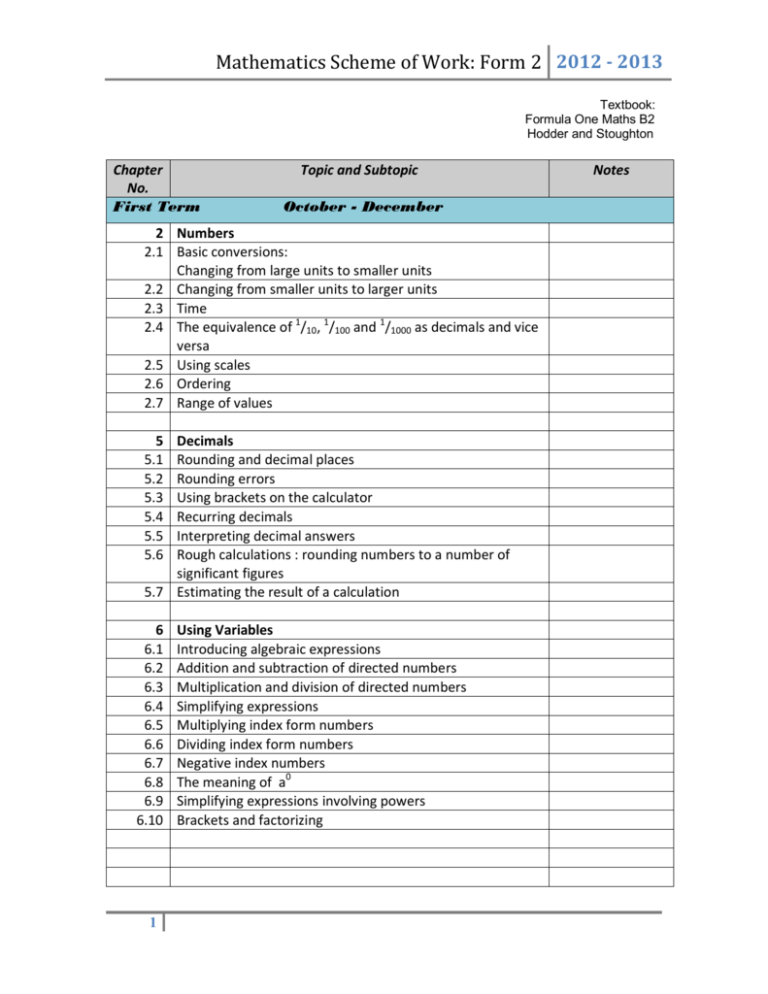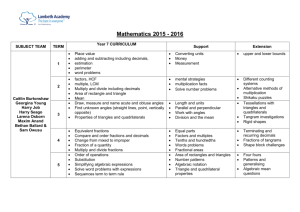Form 2 Maths Scheme of Work 2012-2013
advertisement

Mathematics Scheme of Work: Form 2 2012 - 2013 Textbook: Formula One Maths B2 Hodder and Stoughton Chapter No. First Term Topic and Subtopic October - December 2 Numbers 2.1 Basic conversions: Changing from large units to smaller units 2.2 Changing from smaller units to larger units 2.3 Time 2.4 The equivalence of 1/10, 1/100 and 1/1000 as decimals and vice versa 2.5 Using scales 2.6 Ordering 2.7 Range of values 5 5.1 5.2 5.3 5.4 5.5 5.6 Decimals Rounding and decimal places Rounding errors Using brackets on the calculator Recurring decimals Interpreting decimal answers Rough calculations : rounding numbers to a number of significant figures 5.7 Estimating the result of a calculation 6 6.1 6.2 6.3 6.4 6.5 6.6 6.7 6.8 6.9 6.10 1 Using Variables Introducing algebraic expressions Addition and subtraction of directed numbers Multiplication and division of directed numbers Simplifying expressions Multiplying index form numbers Dividing index form numbers Negative index numbers The meaning of a0 Simplifying expressions involving powers Brackets and factorizing Notes Mathematics Scheme of Work: Form 2 2012 - 2013 13 13.1 13.2 13.3 13.4 13.5 13.6 13.7 Prime Factors, LCMs and HCFs Prime factors and products of primes Expressing a number in its prime factors Prime factors of square numbers and cube numbers Lowest common multiple LCM Problems involving LCM Highest common factor HCF Problems involving HCF 7 7.1 7.2 7.3 7.4 7.5 7.6 7.7 7.8 7.9 7.10 Constructions Constructing an angle of 600 Constructing an angle of 900 Bisecting an angle Bisecting a line (Perpendicular bisector) Dropping a perpendicular from a point to a line Constructing shapes Constructing perpendiculars Scale drawing Angle of Elevation Angle of Depression 2 Mathematics Scheme of Work: Form 2 2012 - 2013 Second Term 10 10.1 10.2 10.3 10.4 January - March Fractions Equivalent Fractions Common denominators Adding fractions Mixed Numbers 23 Multiplying and dividing fractions 23.1 Understanding that dividing by a number is the same as multiplying by 1/that number 23.2 Dividing fractions by a whole number 23.3 Reciprocals 23.4 Dividing whole numbers or fractions by a fraction 18 18.1 18.2 18.3 18.4 18.5 18.6 18.7 Percentages Expressing percentages as fractions Expressing percentages as decimals Expressing fractions and decimals as percentages Finding the percentage of a quantity Expressing one quantity as a percentage of another Problems Everyday percentages (percentage increase and decrease) 15 15.1 15.2 15.3 15.4 Ratios and Proportions Proportions Simplifying Ratios Finding missing quantities in a known ratio Sharing in a given quantity 20 20.1 20.2 20.3 20.4 Equations Solving Linear Equations Solving equations with an unknown on both sides Solving equations with brackets Using equations to solve problems 16 Using Formulae 16.1 Substituting values in a formula 16.2 Using formulae to solve problems 3 Mathematics Scheme of Work: Form 2 2012 - 2013 Third Term 1 1.1 1.2 1.3 1.4 1.5 1.6 17 17.1 17.2 17.3 17.4 17.5 17.6 17.7 17.8 17.9 3 3.1 3.2 3.3 3.4 3.5 3.6 4 April - June Co-ordinates and Graphs Plotting co-ordinates in all four quadrants Finding the co-ordinates of the mid-point of a line The equation of a line Drawing straight line graphs The gradient of a line How to calculate the gradient of a line Measuring Perimeter, area and volume Area of rectangle Area of a triangle Volume of a cuboid Area of a parallelogram Area of a trapezium Area of compound shapes Volume and surface area Volume of Prism Angles Types of Angles Geometrical Facts Angles in a triangle Angles in a quadrilateral Angles at intersecting lines The exterior angle of a triangle





